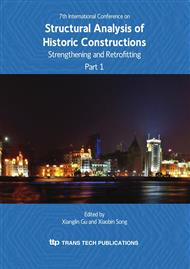p.1083
p.1089
p.1095
p.1101
p.1107
p.1113
p.1119
p.1125
p.1131
"Respecting the Diversity" - The Timber Roof of the “Cannons Loggia” in the Thun Castle (Italy)
Abstract:
Historical timber structures can be considered a paradigm of the “diversity”, which characterizes each individual artefact or part of it and represents a mark of heritage authenticity. In this paper, the term “diversity” indicates both the “variability” of the structure at its different hierarchical levels, and the “variation” in the typological form. Recognising, capturing and interpreting these peculiarities have been a main task, in the restoration of a timber roof in the Thun Castle (Trentino, Italy). After an exceptional snowfall the roof over the Cannons Loggia partially collapsed. In order to properly investigate the causes of the damages occurred to the structure and provide the necessary information for the intervention planning, a throughout investigation campaign was carried out. The adopted approach to repair aims at respecting the roof “diversity”, which is at the same time the mark of its originality and the cause of its deficiencies, relying on reversible and minimal interventions.
Info:
Periodical:
Pages:
1107-1112
Citation:
Online since:
October 2010
Price:
Сopyright:
© 2010 Trans Tech Publications Ltd. All Rights Reserved
Share:
Citation:


